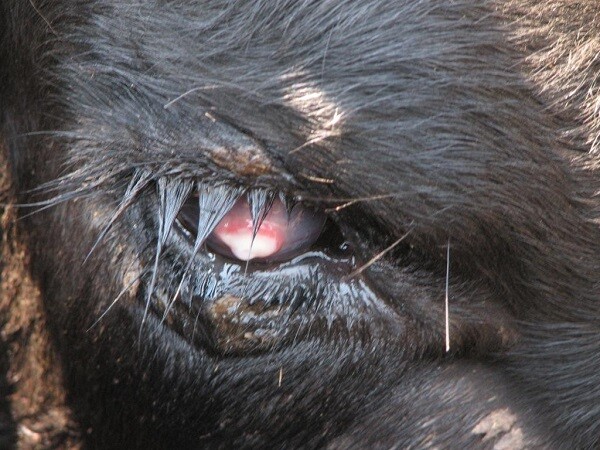

When cattle are observed to have cloudy, runny eyes, it is expected that the inflamed and painful eyeballs and eyelids are infected with a virus or bacterium or are damaged from sunlight or cancer. Close observation, available history, laboratory testing, and professional assistance may be necessary to make a specific diagnosis and proper treatment. Possible causes of this can include pink eye, IBR virus eye, cancer eye, or photo eye.
Pink eye (infectious keratoconjunctivitis): Although sporadic cases of eye diseases occur in all seasons of the year, this highly contagious, bacterial disease is most common during the summer months. Sudden onset begins with excessive flow of tears, holding the eye partially closed, rubbing the eye, and seeking shaded areas. An ulcer develops within a short time in the central area of the cornea. An opaque ring develops around the ulcer, and within 48 hours of onset, the entire cornea becomes cloudy. The infection may affect one or both eyes. The lining of the eyelids becomes red with mucus and pus.
As the ulcer deepens and extends completely through the cornea, the eye ruptures with loss of fluid and collapse of the eyeball. Immediate treatment and isolation of infected cattle are essential to recovery and in prevention of spread to other cattle. IBR virus eye (infectious bovine rhinotracheitis): Upper respiratory infections are caused by the aerosol transmission of this virus that spreads rapidly through the herd and is most prevalent in the fall and winter. In the early acute stage, few cattle may develop cloudy cornea similar to pink eye. The opacity spreads inward from the outer edge of the cornea, with no ulceration. Control measures include isolation of affected animals and vaccination of the whole herd and purchased replacements. Cancer eye (squamous cell carcinoma):
The frequency of cancer, like smooth plaques on the eyeball and ulcer or horn lesions on the eyelids, is increased in cattle without pigment in the eye and with constant exposure to bright sunlight. Excessive flow of tears occurs as in cases of pink eye. Cancerous growths develop on the third, upper, and lower eyelids and eyeball and spread to internal lymph nodes and organs.
Recognizing the gross appearance of the lesions associated with the eye makes diagnosis of this cancer possible. Early detection is necessary for heating or freezing therapies, or surgical removal of the tumor alone. In chronic cases with more extensive involvement, the entire eyeball and eyelids must be removed. Photo eye (photosensitization): This noninfectious condition is a hypersensitivity to sunlight after ingestion of various plants or administration of certain drugs. In addition to cloudiness of the cornea of eyes, non-pigmented eyelids and nose, teats and vulva, and areas of head, body and legs are commonly sunburned. Prolonged exposure of affected cattle to sunlight will cause blindness and severe skin damage. Sheltering during the day with grazing on pasture at night must be provided for protection from sunlight until the eyes and skin have healed.
 Contact Jaguza Support
Contact Jaguza Support